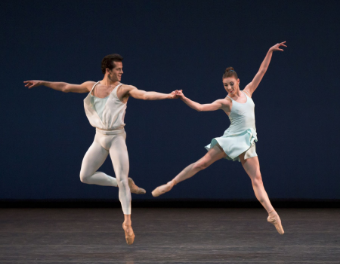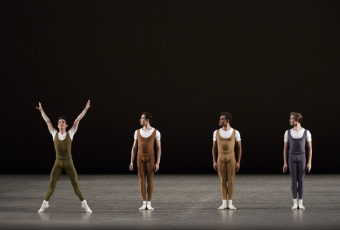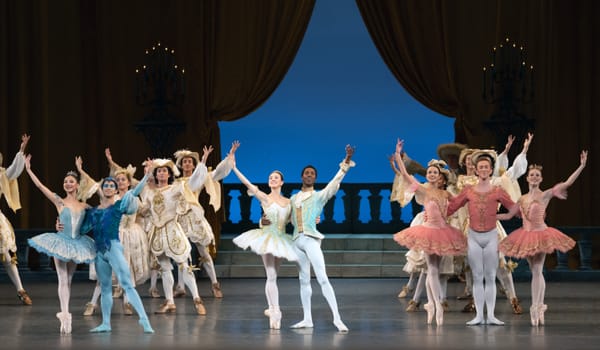Dancing the Music

“Hallelujah Junction,” “A Place for Us,” “The Goldberg Variations”
New York City Ballet
David H. Koch Theater
New York, NY
February 6, 2015
Amidst portrayals of stories and emotions, it is sometimes easy to forget what dance is inherently about: expression of music. In a mixed bill to mostly piano accompaniment, New York City Ballet presented three works that served as an excellent reminder of that, and the dancers did a fine job dancing the scores.
Peter Martins’s “Hallelujah Junction” to John Adams’s composition by the same title opened the night and set the focus of the evening on movement. With choreography that was intimately linked to the music, which was expertly played on two pianos at the back of the stage by Cameron Grant and Susan Walters, the dancers became reflections of the repetitive score that brought passages in and out of phase which each other.
In the principal cast Chase Finley made a debut as the man in white, but despite great presence his dancing seemed focused on getting the steps right, particularly when he partnered Sterling Hyltin in the second movement, where he seemed to be watching her inspired performance rather than engaging with her in their promenades. Contrasting Finley, Daniel Ulbricht as the man in black excelled at the choreography with fast footwork and turns, even if at times, perhaps because of the music’s speed, some of these impressive technical moments lost nuance. Regardless of this, while the work overall felt a little under-rehearsed and in a number of sections the performance would have benefited from more enunciated leans from the three leads and the eight supporting dancers to highlight the asymmetry of shoulder placement that mirrors the asymmetry of the music in Martins’s choreography, certain sections, particularly the splashes of jumps in arabesques in the second movement by the leads, excelled at vividly painting Adams's chords.
On the other end of the evening’s program was Jerome Robbins’s “The Goldberg Variations,” and although it is very different to Martins’s creation, the choreography was similarly tethered to the accompanying score of Johann Sebastian Bach’s opus by the same name, and served as an even better vehicle for showing the various elements of this company’s dancing and the composer’s patterns. Running well over an hour thanks to Robbins’s use of every repetition in Bach’s score, which was played eloquently by Cameron Grant on the piano, this ballet is undeniably long, but the distilled simple movements interspersed with Robbins’s choreographic adventurousness put “The Goldberg Variations” in a class of its own, and the ballet, appearing in NYCB’s repertory for the first time this season since 2008, did not disappoint.
With “Goldberg,” Robbins was, by his own admission, stepping out of his comfort zone of Chopin music, and experimenting with movement and the endless depths of Bach’s musical complexity. The first section, with its many ballet class-like elements and reductions of movements to their academic building blocks, as well as creative uses of acrobatics, revolutionary at the time same-gender partnering, and even warm-up techniques (floor barre, anyone?) has a way of feeling like a choreographer’s, but also dancers’, creative laboratory, connecting the viewer to the construction process of the dance art form. The subtle transitions from different moods and styles throughout the piece, to, ultimately, the baroque influenced mood and costumes in the last section, only serve to reinforce that sense in the ballet as a whole.

The great casting choice of the company’s young and promising dancers in the first part and the established stars in the second fed into that motif, with the dancers enthusiastically explored the entire palate of dance language to the score. From the start, one of the two female leads of the first section, Emilie Gerrity, lit up the stage with all the radiance and joy of a passionate artist at the start of her career. But as she gently controlled her arms, attentively softening them when the music fell more demure, she seemed a dancer not only happy to be doing her craft, but one to watch as well. Another female lead, Lauren Lovette, together with her partner, the promising Taylor Stanley, introduced delicacy and attention to phrasing present in the music in the third variation of the score. Of note also was Joseph Gordon, who struck a careful balance in his dancing between appearing confident and still projecting the experimental nature of the first section.
The ballet’s more mature second section became a great showcase of the different types of great NYCB’s ballerinas. Ashley Bouder out-danced her partner Joaquin de Luz with a commanding presence, making the movements of their initial dance feel like fun even in its homage to baroque dance with the open arm positions. Later, Bouder and de Luz’s slow duet could have easily been a stand-alone piece, with her using the hand gestures towards the audience as de Luz rotated her in an attitude to the front to connect with the audience. Sterling Hylting and Jared Angle as the second leading couple handled their duet’s mood changes from elegant to jovial seamlessly and with great mastery. Particularly beautiful was the transition when Angle twisted Hyltin from a turn with her body deflated forward and let her flourish into a grand developpé that expanded into a lift. Sara Mearns and Tyler Angle, who replaced Adrian Danchig-Waring in the performance, rounded off the cast of principals in the second part, and expertly danced their sections. Mearns, for her part, approached all of the jump lifts with impressive control, and having perhaps the best back in the company used it and her arm placement to give her movements breadth. But her dancing did suffer somewhat in the later portion of the ballet, when, changed into the more baroque costumes, she hardly modified her style: from the beginning to end, what the audience saw was Mearns being Mearns to the changing music.
Wedged between these two works was Christopher Wheeldon’s 2013 piece, “A Place for Us,” starring the ballet’s original cast of Tiler Peck and Robert Fairchild. The recently married couple made the romantic first part especially intimate and beautiful, and its tender moments, like the part where the couple holds their hands in front of each other wanting to touch, and then passionately erases that intervening space as their palms connect, were rich with unsaid emotions that nonetheless felt obvious. The musicians appearing on stage with them, Steven Hartman on the clarinet and Nancy McDill on the piano, blended the André Previn and Leonard Bernstein music with Peck’s and Fairchild’s expressed emotions. Soft and yearning in the first half and playful in the second, with coquettish looks after turns over the shoulder from Peck, the ballet made for a lovely interlude in a mixed bill of beautifully danced music.
copyright © 2015 by Marianne Adams



